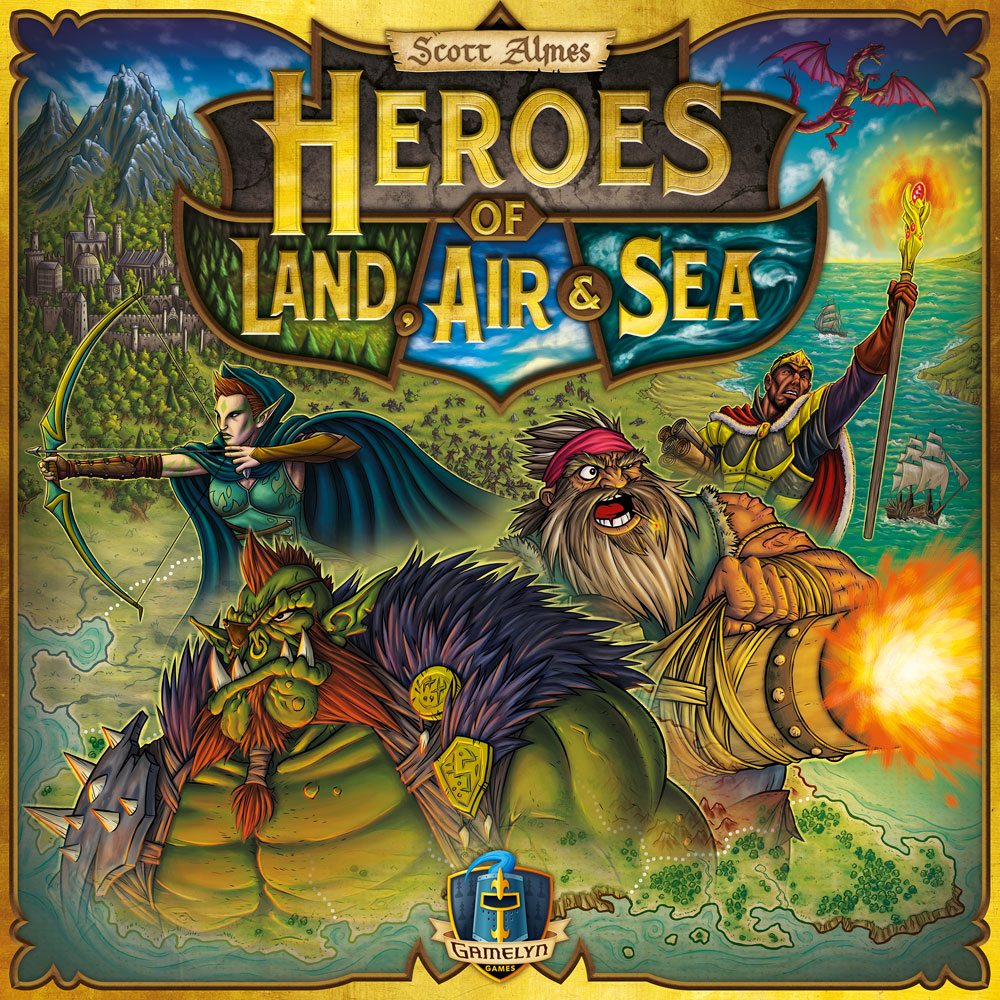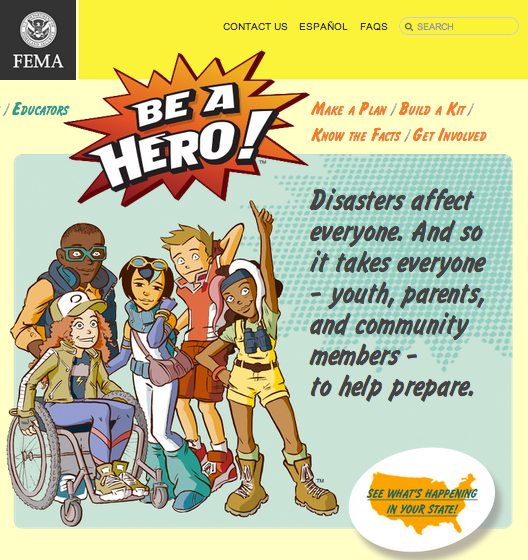Scott Almes and Gamelyn Games, the creators of the Tiny Epic series of games, have teamed up again: but this time it’s for a BIG 4x game: Heroes of Land, Air & Sea. Or, as I like to call it, Massive Epic Kingdoms.
At a glance: Heroes of Land, Air & Sea is a 4x game for 2 to 4 players (up to 6 with expansions), ages 14 and up, and takes about 30 minutes per player. It’s currently funding on Kickstarter (having hit its goal on the first day), with various pledge tiers ranging from $60 to $200 that include expansions and miniatures. I’ll break down the tier options a little later. I would say the game’s rules are not difficult—there are just a lot of them—so the game may be okay for slightly younger players if they’re experienced; primarily they need to have the patience and attention for a longer game. The game is set in a fantasy world and includes warfare, but does not have anything particularly inappropriate for kids otherwise.
New to Kickstarter? Check out our crowdfunding primer, and visit our curated page for more projects we love.
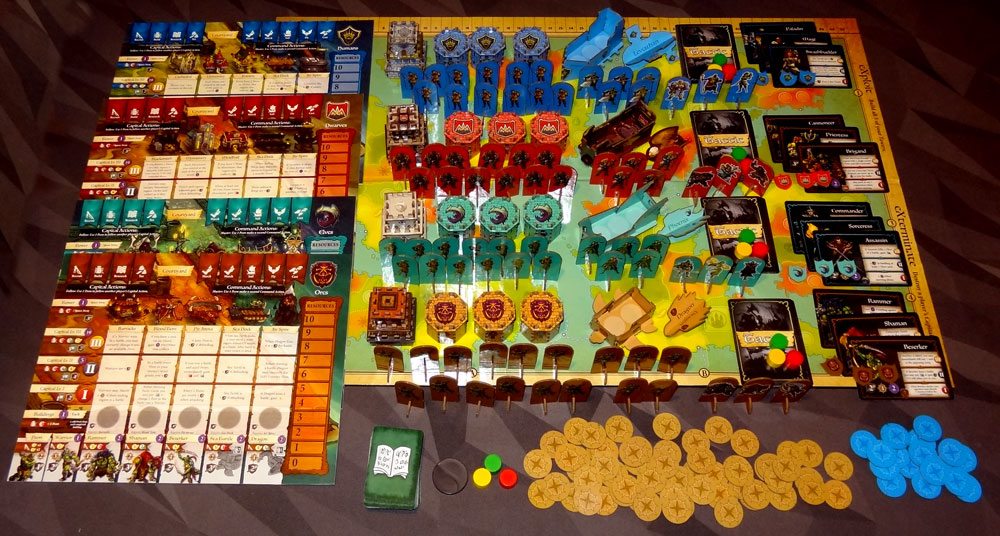
Components
Note that my review is based on a pre-production prototype, so it does not reflect final component quality. In addition, the components list may be affected by stretch goals reached during the funding campaign.
The base game includes:
- Game board
- First Player token
- 3 Resource tokens for Tax action
- 78 Exploration tokens (66 Land, 12 Sea)
- 48 Spell cards
- 4 sets of Faction components (Humans, Orcs, Dwarves, Elves):
- 3 Heroes
- 5 Warriors
- 12 Peons
- 3-part Capital City
- 3 Towers
- 1 Sea Vessel
- 1 Air Vessel
- 1 Faction board
- 3 Resource tokens (Food, Magic, Ore)
- 3 Hero cards
- 7 Tactics cards
- 2 Action tokens
- 1 scoring token
There are a lot of components in this game, and a lot of them are big components. It’s almost as if Gamelyn Games is making up for all those extra-tiny meeples and resource bits they’ve had in their Tiny Epic series for so long. There are two expansions also available—each one includes two more factions. The Order expansion includes Lionkin and Undead, and the Chaos expansion includes Lizardfolk and Goblins. Each expansion includes a similar list of faction components as above.
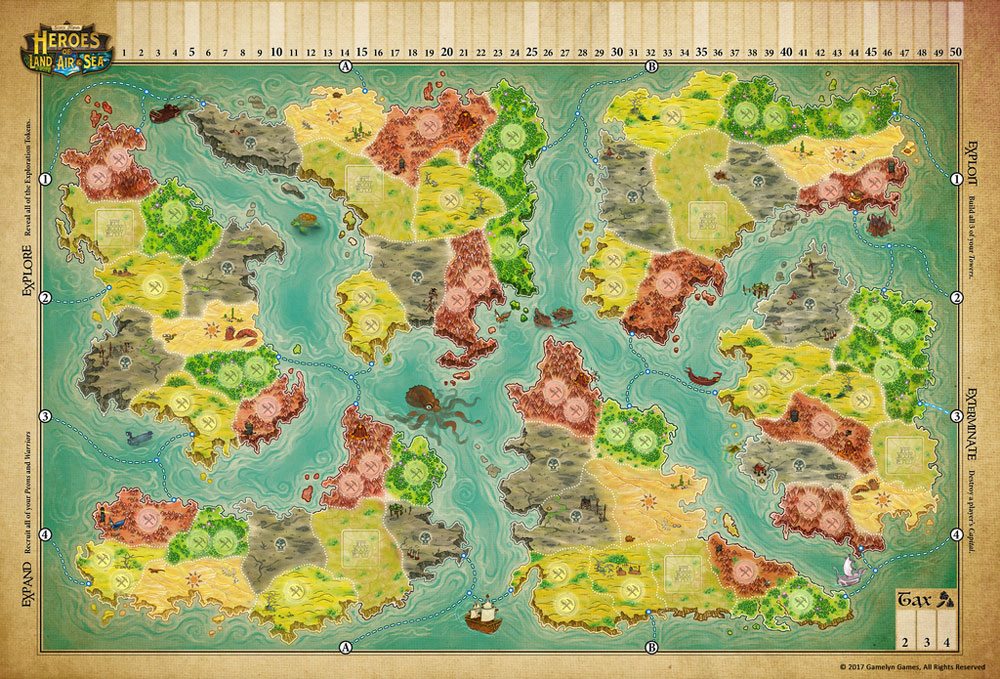
The board itself is a 6-fold board, and will measure 39″×26″—roughly twice the size of the prototype board in my photos. That’s a good thing, because there’s a lot of stuff that will go on that board—miniatures and towers and sea vessels with miniatures in them. The board has several continents, each divided up into various different types of territories, and there are ferry routes that connect some of the islands, including off the edges of the board to wrap around. (It occurred to me that, because of the way the routes connect, this world is actually a torus instead of a sphere…) You’ll need a pretty big playing area for this game, because you’ll also need room for the faction boards, not to mention all the bits.
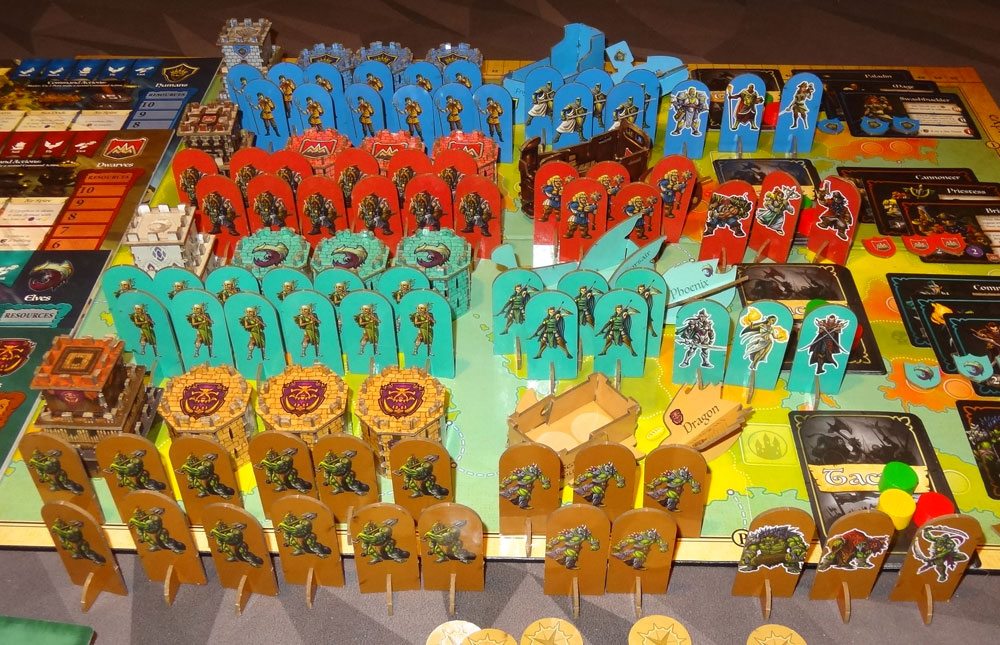
Each faction has its own board and units—the human peons look different from the orc peons, and so on. The peons and warriors are all functionally equivalent to those of other factions, but the three heroes are unique to each faction and to each other (and the cards indicate each hero’s abilities). I’ll note that while there are some female characters, they’re pretty heavily outnumbered (except in the Elves faction) by male characters—moreso because the peons and warriors for each faction only have one model each. It’s harder to say with some of the others, like Lizardfolk and Undead…
The faction board can be a little overwhelming at first, but it lists all of your potential actions across the top, and then all of the costs and benefits for your buildings, your city, and various units. I’ll explain more about this in the rules.
There are several cardboard constructs involved—the towers, vessels, and capital cities—and they’re pretty cool. The vessels will be like little boxes that can hold a number of units to move them around, and the air vessels will have clear plastic bases so they look like they’re flying. The capital cities are three-tiered square castles: when you upgrade your city, you physically add another tier onto the board. Be sure to visit the Kickstarter page for images of all the components, since the versions in the prototype are not representative of the final components.
You’ll be able to get the game with cardboard standees, plastic miniatures, or even pre-painted plastic miniatures, depending on the pledge level. (Note: Only the three hero miniatures from each faction will come pre-painted, not the peons and warriors.) The prototype uses cardboard standees (although they are not shaped cutouts), and the “standee” pledge tiers were added because a lot of people wanted to back the game but found the cost of miniatures prohibitive.
The pledge levels include options for the base game, base game + 1 expansion, and base game + 2 expansions. Here are the various costs for the different tiers:
| Base Game | Base + 1 Expansion | Base + 2 Expansions | |
| Standees | $60 | $85 | $110 |
| Unpainted Miniatures | $100 | $140 | $175 |
| Pre-painted Miniatures | $125 | $175 | $220 |
As you can see, it’s not a cheap game, but you are getting a whole lot of components for that price, and each expansion has almost half as many components as the base game. These prices are lower than the expected retail price, too, so if you’re interested now is a good time to lock in that price.
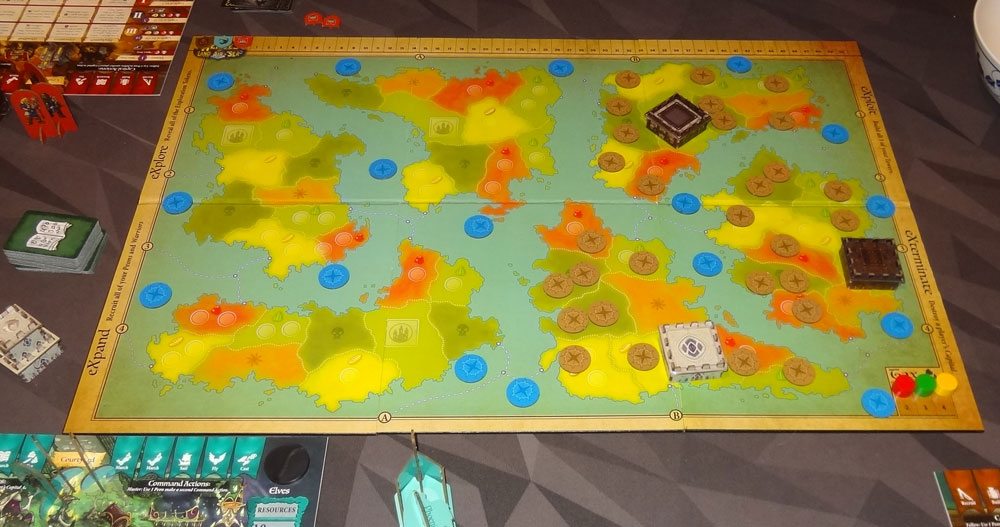
How to play
You can download the prototype rules here.
Heroes of Land, Air & Sea is a 4X game, a genre named after four Xs: Explore, Expand, Exploit, Exterminate. Generally these type of games include exploration on a map of some sort, increasing your population (or army, or fleet, etc.), building up your technology and abilities, and attacking other players. Both Tiny Epic Kingdoms and Tiny Epic Galaxies were also 4X games, though with different styles of play. Heroes of Land, Air & Sea is most similar to Tiny Epic Kingdoms in terms of the fantasy theme and some shared concepts, though it is not simply a larger version of the game.
The goal of Heroes of Land, Air & Sea is to have the most points at the end of the game, which is triggered when one of the four Xs has been completed. You score points for various things: controlling territories; recruiting units; building towers, your capital city, and buildings; winning combats and casting spells during the game; and a few other methods.
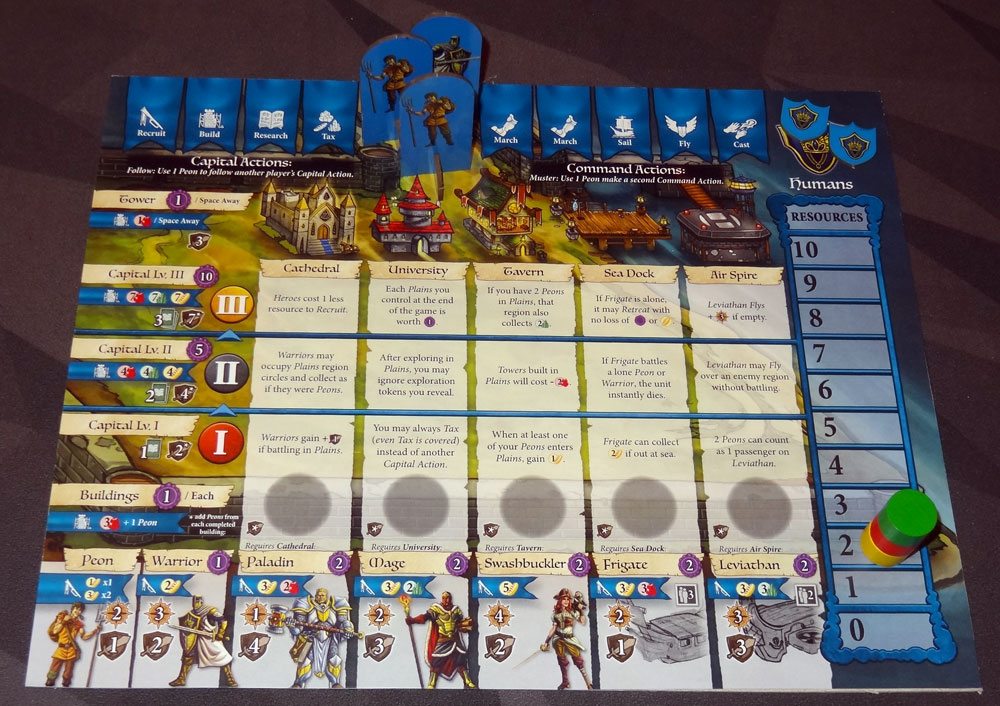
At the start of the game, each player will choose a faction and starts with 2 peons and 1 warrior, as well as 2 of each resource (food, ore, magic), tracked on the faction board. Players will choose one of the continents as a starting location, building their level 1 capital city on the indicated space, and then seeding the board with face-down exploration tokens on land and in the water. Not all of the continents will be used unless you’re playing a 6-player game, so some continents may remain totally empty.
Players will take turns choosing actions, one at a time, until each player has chosen 2 actions. Then everyone gets to collect resources based on territories they control, and then the first player token shifts to the next player.
There are two types of actions: capital actions and command actions. Capital actions can be “followed” by other players if they have available peons; if you take a command action, you may “rally” to take a second command action on your turn if you spend a peon.
Capital Actions: Recruit, Build, Research, Tax. Command actions: March, Sail, Fly, Cast.
Recruit: Pay costs to recruit units from your supply, placing them in the courtyard on your board. At the beginning of the game, you can only recruit peons and warriors; in order to recruit heroes or vessels, you must have built the associated building in your city.
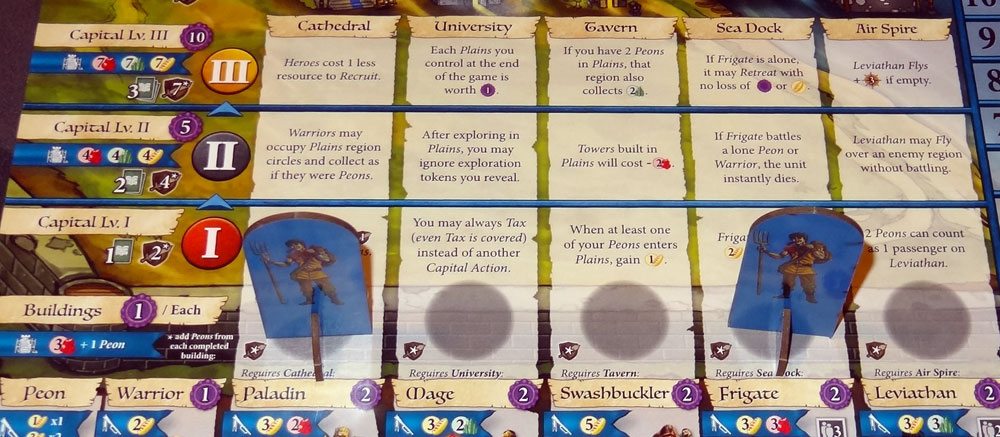
Build: Pay costs to build a building, a tower, or your capital city.
- Buildings: You have five different buildings in your capital city—each provides bonus abilities and allows you to recruit a specific hero or vessel. Each building has three abilities, and they’re unlocked automatically as you upgrade your capital city. To build a building, you must have an available peon, which is then placed on the building spot of your faction board to indicate that it’s been built.
- Towers: Towers are worth points, help defend a territory in battle, and help you collect resources. The further they are from your capital city, the more they cost, and the more points they’re worth. They’re also considered adjacent to your courtyard, so you can deploy units directly into faraway regions with towers. You may only build a tower in a region that has one of your peons in it.
- Capital city: Your capital city’s level (from 1 to 3) indicates how many spell cards you can hold, how much defense your city has, and how many points it’s worth. In addition, each time you upgrade your city, you also upgrade the abilities of all of the buildings you have built, as well as any heroes you have recruited.
Research: Draw three spell cards, and then discard down to the current level of your city.
Tax: On the main board, there’s a tax section showing three resource icons at values 2, 3, and 4. You may choose one of those resources and then gain the indicated amount. Then, rotate the tax section so the 4-valued resource drops to 2.
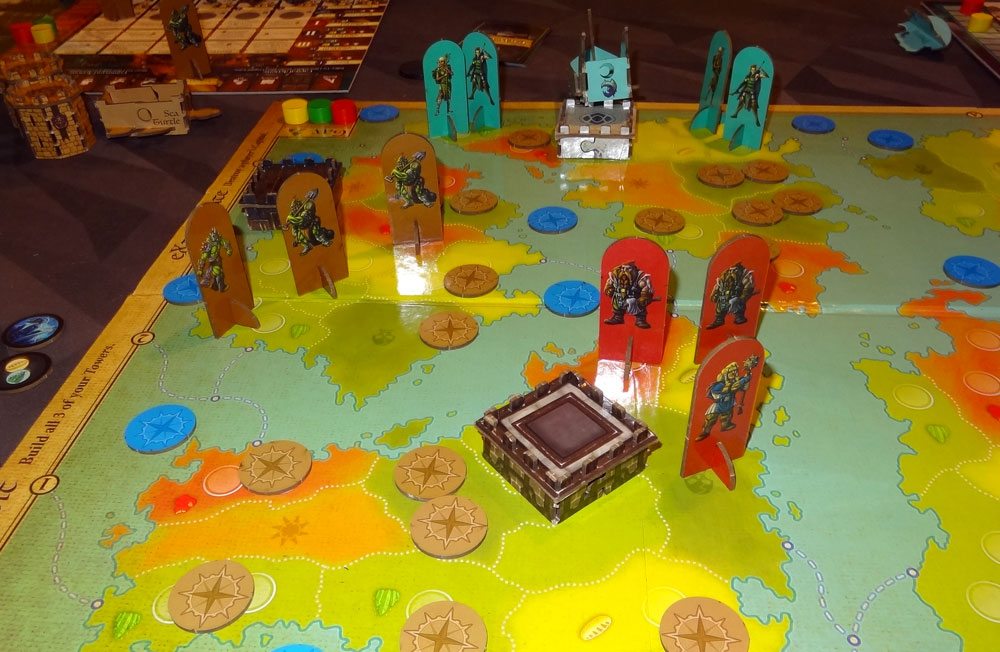
March: Move a group of up to 5 units across land (and ferry routes)—the number of spaces you may move is indicated by the slowest unit in the group. If you encounter an enemy, you must stop movement and initiate war. Otherwise, when you end movement, you reveal and resolve any exploration tokens in that space. There are two March spaces on the board so you can take this action twice.

Sail: Move your sea vessel equal to its speed. Sea vessels can carry a number of units with them if desired, will initiate battle if encountering other sea vessels at sea, and will reveal exploration tokens when they stop movement.
Fly: Move your air vessel equal to its speed. Like sea vessels, air vessels may also carry units, and will also initiate battle.
Cast: Cast a spell from your hand by paying its magic cost and then taking its effect. You also gain points on the scoring track when casting a spell.
Battles take place whenever you end your movement in an enemy space. Players secretly choose one of their seven tactics cards to play, and then reveal simultaneously. Each tactic card has a strength value, a resource cost, and some effects—like how it interacts with other tactic cards. You add up your strength, including the strength of units and towers and buildings, and see who is higher; defenders win ties. The winner must pay the cost of the tactic card, but also gains points based on the card played. The loser loses half (rounded up) of their army’s strength value (returning it to the supply), and then moves remaining units to their nearest capital city or tower.
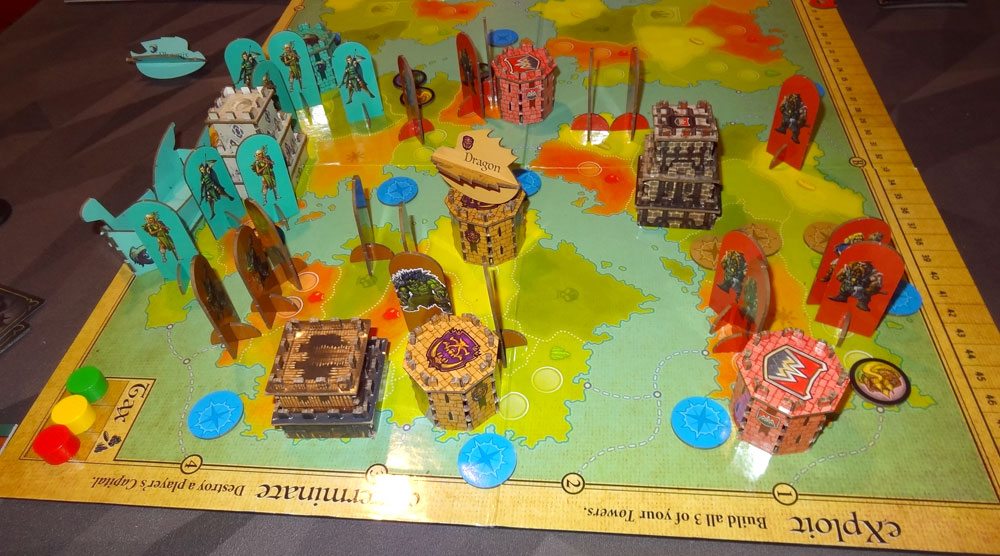
Play continues until one of the end-game triggers, at which point you finish the round and play one more full round.
- Explore: All of the exploration tokens have been revealed.
- Expand: A player has recruited all of their peons and warriors.
- Exploit: A player has built all three of their towers.
- Exterminate: A player has defeated another player’s capital city. (In this case, the game ends at the end of this round, and no additional round is played.)
Then, you add up all your points from your various sources, and the highest score wins.
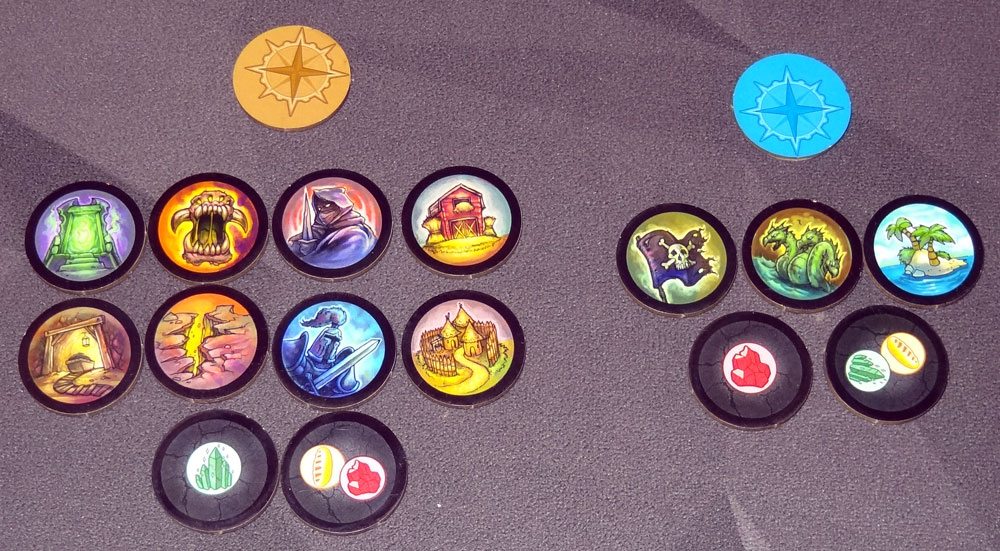
The Verdict
As I’ve said before, I’m a fan of both Scott Almes and Gamelyn Games, and I’ve really enjoyed the Tiny Epic series so far. Together they’ve created several titles that pack a healthy dose of gameplay in a small package. So I was really curious about this one, which is another 4X title but in a very big package.
Okay, first, one minor gripe from me: the name. I really feel like they missed an opportunity to call it Massive Epic Kingdoms or something along those lines, to tie it to their previous titles. But mostly I’m wondering what people will end up calling it, because gamers even shorten titles like Settlers of Catan. But you can’t shorten this just to Heroes, right? Maybe the acronym: HOLAS? I guess we’ll see.
Now, to more serious matters. Almes and Gamelyn have built up a pretty solid community over the course of eight successful Kickstarter campaigns, and I think it’s on the strength of their previous titles that so many backers are willing to take a chance on Heroes of Land, Air & Sea even though it’s a massive box at a significantly higher price point. The funding goal of $100,000 is much higher than previous campaigns, but even then it reached funding on the first day. Michael Coe of Gamelyn Games has always been great about listening to his backers, too—when people complained about the price, he added pledge tiers for standees only to drop the price, even though the die cuts for standees are costly and having an additional product type makes things more complex for fulfillment.
The components in this game are really impressive and huge. It’s really satisfying to see your three-tiered city stacking up on the board, and the towers have an imposing presence. Playing on the smaller prototype board, I can definitely see the reason you need such a big board, because a single territory might contain a tower and several units—and that’s before another player brings in a sea vessel filled with enemy units. I can already tell that the full-sized board is going to be a sight to behold, particularly with plastic miniatures instead of cardboard standees.

The thematic ties to Tiny Epic Kingdom are kind of cool, and I think fans of TEK will like the way some concepts carry over. For instance, the three resources (and the associated regions where you collect them) are the same, and the factions have different abilities that will seem somewhat familiar. But HOLAS expands on those significantly. Your faction now has three unique heroes, vessels that can carry units, and five different buildings. I like the way that upgrading your capital city adds new abilities to just about everything: heroes, vessels, and buildings all gain new abilities every time you upgrade—and some of those abilities even affect peons and warriors. While it can feel a little overwhelming looking at your faction board and trying to figure out what to do first, I like that it allows for different paths to victory—the trick is figuring out how best to use your faction’s strengths.
Because of the sheer number of moving parts, HOLAS is substantially more complex than TEK, though primarily because of all the unique abilities to learn. Each player has access to the same set of actions, but the process of selecting actions, following, and rallying is new. The flow of the game is fairly easy to learn after a round or two—however, those prone to analysis paralysis may spend a long time taking a turn because there are so many things to choose from.

Combat isn’t inevitable, but it’s quite likely: you can collect resources on your own island, but you’ll get more points by traveling farther afield to build your towers. The combat system is an interesting one that doesn’t rely on luck. Instead, you choose which tactic card you want to play, based on the resources available to you and what you think your opponent may play. Some tactics cards can only be played by an attacker or a defender. Knowing that you’ll only have to pay the costs if you win makes it possible to gamble a little, too. But what I really like is that because some cards are strong against specific other cards, you can win a battle even if you don’t have the stronger army. It’s really about figuring out your opponent and what they’re likely to play, and trying to come up with a way to counter that.

The magic spells also add to that—if you take the research action and make sure you have spells in hand, you may be able to cast fireballs to damage units before a fight even begins, or add to your own army’s strength before a fight begins. And then there are also other abilities gained through specific buildings or units. For instance, the Orc dragon, their air vessel, can eat an enemy unit before battle begins if the capital city has been built up enough.
Speaking of the capital city, I really like the way those work, too. Building up your capital city isn’t cheap—you’ll have to work on collecting a lot of resources each time you upgrade—but it makes everything better. Your city has a greater strength and point value, your buildings gain more powerful abilities, and your heroes also gain abilities. However, building up your city isn’t as useful if you don’t have buildings and heroes, because the bonus abilities only apply when those buildings and heroes are in play. There’s a balancing act, figuring out which abilities you really want to pursue and then trying to get those into play. Is it better to have a Level 3 city with just a select few buildings, or a Level 2 city with all five buildings? Well, that depends on your strategy.
In most 4X games, you do need to pursue a combination of the 4 Xs, but it’s often advantageous to focus primarily on one or two of them. In HOLAS, there are several different ways to get points. I’ve only had the prototype a short time so far so I don’t have the experience yet to know if one method is better than another yet, but I’m looking forward to exploring different strategies in the future. Can you win by recruiting aggressively and getting all of your warriors and peons on the board before another player upgrades their city? Or maybe you can do a lot of research and just cast spells to earn victory points. I’m excited by the possibilities that HOLAS offers, and I think there’s a lot of replayability there, especially if you throw in the extra factions from the expansions.
Although at first it seemed like HOLAS might appeal to a different audience than the ones who backed the Tiny Epic series—those who like packing a lot of gameplay in a tiny package—based on the Kickstarter campaign I’d say that a lot of people are willing to take a chance on a big game because they trust Scott Almes and Gamelyn Games, and I think that’s going to pay off. If you like fantasy 4X games (particularly Tiny Epic Kingdoms) and you’re ready to try a big game, take a look at Massive Epic Kingdoms today. Er, I mean, Heroes of Land, Air & Sea.
Visit the Heroes of Land, Air & Sea Kickstarter page for images of the miniatures, more information, and to make your pledge!

